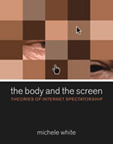June 25, 2006
The Body and the Screen:

Theories of Internet Spectatorship
The Body and the Screen: Theories of Internet Spectatorship by Michele White -- Internet and computer users are often represented onscreen as active and empowered--as in AOL's striding yellow figure and the interface hand that appears to manipulate software and hypertext links. In The Body and the Screen Michele White suggests that users can more properly be understood as spectators rendered and regulated by technologies and representations, for whom looking and the mediation of the screen are significant aspects of engagement. Drawing on apparatus and feminist psychoanalytic film theories, art history, gender studies, queer theory, critical race and postcolonial studies, and other theories of cultural production, White conceptualizes Internet and computer spectatorship and provides theoretical models that can be employed in other analyses. She offers case studies and close visual and textual analysis of the construction of spectatorship in different settings.
White shows that despite the onscreen promise of empowerment and coherence (through depictions of materiality that structure the experience), fragmentation and confusion are constant aspects of Internet spectatorship. She analyzes spectatorship in multi-user object-oriented settings (MOOs) by examining the textual process of looking and gazing, contrasts the experiences of the women's webcam spectator and operator, describes intentional technological failures in net art, and considers ways in which traditional conceptions of artistry, authorship, and production techniques persist in Internet and computer settings (as seen in the creation of virtual environment avatars and in digital imaging art). Finally, she analyzes the physical and psychic pain described by male programmers in Internet forums as another counternarrative to the common tale of the empowered user. Spectatorship, White argues, not only affects the way specific interfaces are understood but also helps shape larger conceptions of self and society.
Michele White is Assistant Professor in the Department of Communication at Tulane University.
Table of Contents
1. Making Internet and Computer Spectators
Introduction
Rendering Liveness, Materiality, and Space
Notions of the Empowered User
Addressing the Spectator
Stabilizing Identity
Erasing the Interface
Conclusion: Active Users by Design
2. Visual Pleasure through Textual Passages: Gazing in Multi-user Object-oriented Settings (MOOs)
Introduction
MOOs
The Look and the Gaze
Character Creation and Attributes in MOOs
The Look and the Gaze in MOOs
Gendered Gazing in MOOs
Graphical MOOs
Conclusion: Between Multiple and Coherent Identity
3. Too Close to See, Too Intimate a Screen: Men, Women, and Webcams
Introduction
Feminism and Spectatorship
Critical and Journalistic Considerations of Webcams
Webcams
Women and Webcams
Regulating the Spectator
Women Webcam Operators and Authority
Visibility and Webcams
Making Texts Real
Some Problems with Webcam Viewing
Just a Guy
Conclusion: The Politics of Being Seen
4. The Aesthetic of Failure: Confusing Spectators with Net Art Gone Wrong
Introduction
Aesthetics and Net Art
Net Art
An Aesthetic of Failure
Jodi
Peter Luining
Michaël Samyn
Conclusion: The Limits of Failure and Repetition
5. Can You Read Me? Setting-specific Meaning in Virtual Places (VP)
Introduction
Virtual Places
Avatars
Painters and Avatar Galleries
Owning Texts
Criteria for Originality
Theories of Internet Authorship
Gender, Race, Sexuality, and the Avatar
Making Differences in Virtual Places
Conclusion: Authorship in Other Internet Settings
6. This Is Not Photography, This Is Not a Cohesive View: Computer-facilitated Imaging and Fragmented Spectatorship
Introduction
Making the Digital Imaging Spectator
Photography
Digital or Post-photography
The Scanner as Camera
Carol Selter's Animalia and Punctum
Susan Silton's Self Portraits and Images of the Partial Self
Ken Gonzales-Day's Skin Series and the Cut
The New Media Grid
Conclusion: The Morphed Spectator
Afterword
The Flat and the Fold: A Consideration of Embodied Spectatorship
Introduction
Carol Selter, Susan Silton, Ken Gonzales-Day, and the Fold
The Body Folded and Evacuated
Hierarchy and Control
The Spectator in Pain
The Fat and the Fold
Men and the Weight Loss "Challenge"
Erotic Folding
Conclusion: A Technology of Waste
Acknowledgments
Notes
Selected Bibliography
Index
Posted by jo at June 25, 2006 04:37 PM
